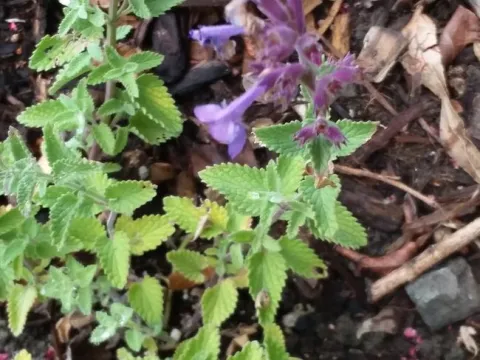
Nepeta
By Polly Nelson UCCE Master Gardener
Common Name: Nepeta
Genus, Family: Nepeta, Lamiaceae
Planting area: Sunset 1-24
Size: Six inches to one foot tall, 2 feet wide.
Bloom season: Spring to fall
Exposure: Full sun, most can tolerate part shade
Pruning needs: Mid-summer, fall
Water needs: Moderate to low
Snapshot:
If you enjoy lavender, Salvias and rosemary in your yard, then you might want to take a look at Nepeta. It is from the mint family, as is rosemary. You and your feline friends may be familiar with catnip (Nepeta cataria); a cousin often confused with N. faassenii or N. racemosa. Catnip is more aromatic but has fewer ornamental attributes than Nepeta.
Nepeta actively grows prostrate or in low mounds. Some grow up to a foot tall. The leaves are heart-shaped at the base, oval at the tip with scalloped edges, are deeply veined and have a soft, hairy texture. The gray-green color contrasts with the blue-violet two-lipped flowers that cluster on long spikes. Nepeta blooms late-spring through summer.
Choose a planting location with well-drained soil in full sun. Clay, sandy or loamy soil will do fine with attention to watering. Nepeta also does well in containers. Containers are recommended to minimize spreading, as this plant readily reseeds itself.
Prune Nepeta twice a year to maximize bloom production and manage the plant's appearance. After the first round of blooms has finished, use pruning shears to cut back one-third to one-half of the plant to encourage a second bloom, then water well. In the fall, remove spent flowers (this helps minimize reseeding) and dead foliage to get rid of hiding places for pests.
Propagating new plants is done in spring, primarily in one of two ways. Propagate by division every 3-4 years by slicing off a section of the plant with several shoots and good roots. Replanting in the desired location, water well and treat it as a new plant with regular water needs for the first year. A second way to propagate is by taking three-inch cuttings from healthy shoots before buds form. Place the cutting in moist medium (sand or peat-perlite mix). Roots should develop within 3-4 weeks.
Hummingbirds, bees and butterflies are attracted to Nepeta; deer are generally not and insect pests are minimal.
Consider adding Nepeta to your garden. Its rich texture and color will add interest and depth to your landscape.
We are still here
You can view workshops on Instagram live at slo_mg or visit our You Tube channel at “San Luis Obispo County UC Master Gardeners.”
Visit our website at ucanr.edu/sites/mgslo/ or email us questions at anrmgslo@ucanr.edu.
Our physical offices are closed, but you can still reach us:
San Luis Obispo: 805-781-5939
Arroyo Grande: 805-473-7190
Templeton: 805-434-4105

